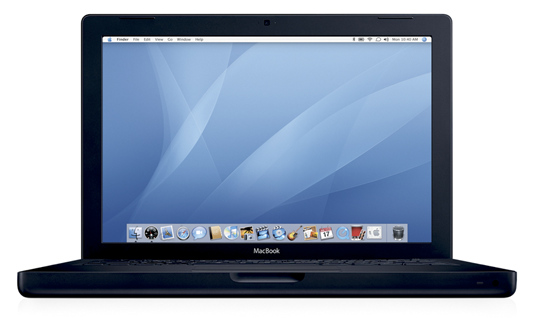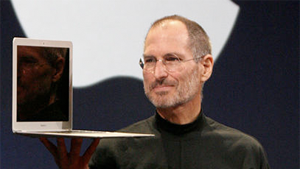
Rumors. Press event. Answers. More questions. That’s the standard cycle with new Apple announcement, and since today’s press event provided lots of answers, we’re now officially in the More Questions phase. This post is not me attempting to put together a definitive FAQ–actually, it’s not a FAQ at all, since some of the questions are unanswerable, or answerable only by people at Apple who’ll probably never tell us. What it is are a bunch of the things I’m still wondering about, complimented with some of the questions asked by the inquisitive folks who attended our live coverage of this morning’s proceedings.
Q. On a scale of 1 to 10, with 1 representing the launch of the Apple Hi-Fi and 10 representing that of the original Mac, how big a deal was today’s news?
A. Interesting question! About a 5, I guess. These aren’t landmark, world-changing products, but they have lots and lots of technical innovations, and people have been waiting for them for a long time. (Even at Macworld Expo in January, an all-new Mac portable lineup seemed overdue.)
Q. What happened to the $800 MacBook?
A. $800 MacBook? Did someone talk about an $800 MacBook? The rumor originated on Duncan Riley’s Inquisitr, with a post that was originally called Exclusive: Apple to Launch $800 Laptop but has now backpedaled to the less definitive Tip: Apple to Launch $800 Laptop. (Wouldn’t Falsehood: Apple to Launch $800 Laptop be even more accurate?) Riley is saying his tipster confused Apple’s new $899 display with an $800 laptop. That’s quite a bit of confusing to do, and it spawned a heck of a lot of hubbub that amounted to nothing. (Although discussing the implications of an $800 MacBook had a certain amount of value even if no such beast exists.)
Q. Maybe the $800 MacBook is real. but in the wings? It’s not unusual for Apple to hold an event, then follow up with related products not too long thereafter.
A. Anything’s conceivable, but if the rumor sprung from misunderstanding of a pricing sheet’s reference to the new display, then it presumably wasn’t rooted in reality at all. I think there’s a good chance that Apple will someday sell an $800 laptop, but the company seems to have no interest whatsover in competing with supercheap, feature-laden Windows machines. In fact, with the exception of the new $999 MacBook–which isn’t that cheap–today’s announcements make the MacBook line even more upscale, and less directly competitive with the teeming masses of cheap Windows laptops out there.
Q. Is it worth getting excited about the new $999 price for the old-style MacBook, which used to be $1299 and remains in the lineup?
A. No, not really–I maintain that $100 price differences aren’t large enough to obsess over when you shop for a PC that costs more than $1000, and this one only makes the old MacBook (which isn’t a bad machine) a slightly better value. Note that there’s nothing historic about a $999 Mac laptop–the iBook once sold for that price.
Q. So should I buy the $999 white MacBook or the $1299 aluminum MacBook?
A. Depends on your budget. The extra $300 for the new model gets you quite a bit: much more style, beefier specs in general, the new Nvidia graphics which are potentially a big deal, and more. On the other hand, new Apple notebook designs sometimes have quality-control issues at first. Early adopters of the new MacBook will learn how robust it is, but the old white MacBook is a tried-and-true design that should be pretty free of surprises.
Q. Hey, are the new Macs expensive compared to comparable Windows machines?
A. For some people, the reflexive answer here will be yes, since even the $999 MacBook costs twice as much as some Windows laptops which are in some ways better equipped. But to me, the most interesting and fairest issue is whether the Macs are pricier than Windows notebooks which are similar. I’ll answer that question, I promise, but I want to do so when I have time to delve into research and space to discuss it at length. One note, though: I’m currently shopping for a 13-inch Windows notebook, and most of them cost a lot more than either the $999 old-style MacBook or the $1299 new-style one.
Q. What’s the deal with the 17-inch MacBook Pro, which is still almost the same basic design that Apple intoduced with the aluminum PowerBook G4 back in 2003? Apple barely mentioned it until someone in the audience asked, and even then nobody from Apple could remember how the new “refreshed” model was better.
A. You got me. It seems unlikely that the now-retro 17-inch MacBook will be along for very long, though. I’m assuming that there’s enough of a market to make it worth Apple’s while to make a new-style one. Perhaps it just couldn’t roll out everything it wanted to at once–if a new 17-incher arrives in the next 90 days, I wouldn’t be startled in the least.
Q. So is Apple’s new “unibody” aluminum-case design the much-discussed “brick” manufacturing breakthrough?
A. Well yes, obviously, although the Apple folks onstage today never called it “brick.” And Apple’s Jonathan Ive did note that it’s based on ideas first expressed in the MacBook Air case earlier this year.
Q. Did Apple build a radically new factory to make unibody MacBooks?
A. I don’t know–if I’d had the chance to ask two questions rather than just one, I might have asked this. Here’s the video we saw at today’s event, with neat footage of a factory cranking them out. I’m assuming that the new Macs, like most computers, are actually built by contract manufacturers, though.
Q. How big a deal are the new Nvidia graphics?
A. I’m always leery about getting excited over new technologies based on theoretical technical excellence and benchmarks as opposed to real-world performance. But they sound neat across the board–the $1299 MacBook gets integrated graphics that close in on the performance of old MacBook Pros with discrete graphics, and the new Pro gets two powerful GPUs. From the standpoint of pure technical innovation, all this looks to be some of the bigger news to come out of Apple in a long time…even if Nvidia deserves most of the glory.
Q. The new touchpad–good idea? Bad? Neutral?
A. I wanna use it more before coming to any conclusions. Sorry!
Q. The new MacBook has no FireWire–a technology that Apple invented. Is that bad? Is it sign of things to come?
A. I don’t think it’s a huge deal. Professionals who use serious camcorders and superfast external hard drives still want FireWire, and the MacBook Pro still has it–in fact, it’s really part of what makes the Pro a pro product. For consumers, though, I think USB is fine. (I cheerfully admit to basing this conclusion on my own experiences: The only time I’ve used FireWire on my MacBook recently is to hook it up to another Mac for file transfers.)
Apple has a long history of getting rid of features that seemed mandatory a bit before the rest of the industry–floppy drives and dial-up modems come to mind–but it generally makes the right call, and I suspect it has here. This does, however, put the $999 old-style white MacBook in the odd position of having a port of interest to advanced users that’s missing in the pricier, more powerful new-style MacBook.
Q. Speaking of the old white MacBook, isn’t it kind of confusing that it has the same name as the new Macbook, even though it’s quite different?
A. Yes. Apple’s site calls it the “white 13-inch MacBook.” Which is accurate, but its whiteness is probably not the most significantly different thing about it compared to the new 13-inch MacBook. Maybe it should be called the “cheap MacBook” or the “plasticky MacBook?”
Q. How about Steve’s health? Did Apple Chief Operating Officer Tim Cook and Senior VP of Industrial Jonathan Ive do some of the heavy lifting at today’s event because Steve couldn’t, or to usher them in as potential substitute Steves?
A. I don’t like talking about Steve Jobs’ health and its relation to Apple as a business; I’m neither a doctor nor a financial analyst, and the guy deserves his privacy. Suffice it to say that he appeared only briefly at the start of the event, then Cook and Ive did some of the presenting that Jobs might typically have done. But then he came back for the rest of the presentation, took questions, and chatted with attendees at the end. As to Cook and Ive and their involvement in the presentation, it made sense to me–Cook talked about sales stuff, which was logical for an operations guy, and there’s nobody in the world I’d rather hear talk about industrial design than Jonathan Ive. I kind of think it makes sense for multiple Apple execs to be public faces of the company, no matter what.
Got more questions? I do…and I’ll probably either append them to this post or tackle them in a sequel…
 “There are some customers which we choose not to serve. We don’t know how to make a $500 computer that’s not a piece of junk, and our DNA will not let us ship that.”
“There are some customers which we choose not to serve. We don’t know how to make a $500 computer that’s not a piece of junk, and our DNA will not let us ship that.”

 A couple of days ago when I posted my
A couple of days ago when I posted my  One of the nice things about Technologizer is that reviewing products can be a process that never quite ends. I give my
One of the nice things about Technologizer is that reviewing products can be a process that never quite ends. I give my 


 Yesterday, I posted about the fact that Steve Jobs usually doesn’t take questions at Apple press events–except when he does. I said that if he did,
Yesterday, I posted about the fact that Steve Jobs usually doesn’t take questions at Apple press events–except when he does. I said that if he did,